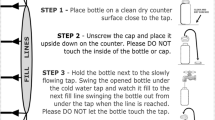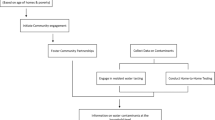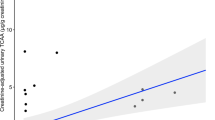Abstract
Consumption of nitrate and nitrite is associated with a variety of health outcomes. Commercially available test strips that allow semi-quantitative estimation of these contaminants in drinking water are inexpensive relative to laboratory testing, and are simple to use. To examine the accuracy of a nitrate/nitrite test strip, we recruited Washington State residents to estimate levels of these contaminants in their tap water using these strips, and simultaneously provide a tap water sample for laboratory analysis. Paired results were available from 102 homes. On the basis of laboratory assay, nitrate levels as nitrogen ranged from no nitrate (27%) to 40.5 mg/l (median 0.4 mg/l). Spearman's correlation coefficient between test strip- and laboratory-measured nitrate indicated moderate precision overall (r=0.72). Correlation was similar for homes inside and outside city/town limits, but differed by primary source of water for the purveyor indicated by residents (r=0.72 for groundwater and r=0.34 for surface water). Seven (7%) participants reported difficulty in distinguishing colors (contaminant levels) when using the test strip; and among the samples with nitrate, the laboratory assay indicated higher nitrate levels than the test strip for 81%. Nitrite was not detected by laboratory assay; in comparison, five (5%) subjects reported any nitrite according to the test strip. Nitrate/nitrite test strips may be useful in some epidemiologic studies, but should be used with caution, preferably as a screening tool or when laboratory assays are not feasible.
This is a preview of subscription content, access via your institution
Access options
Subscribe to this journal
Receive 6 print issues and online access
$259.00 per year
only $43.17 per issue
Buy this article
- Purchase on Springer Link
- Instant access to full article PDF
Prices may be subject to local taxes which are calculated during checkout
Similar content being viewed by others
References
Armstrong B., White E., and Saracci R. Principles of Exposure Measurement in Epidemiology. Oxford University Press: Oxford, 1994.
Bischoff M., Hiar A., and Turco R. Evaluation of nitrate analysis using test strips: comparison with two analytical laboratory methods. Commun Soil Sci Plant Anal 1996: 27: 2765–2774.
Grosse Y., Baan R., Straif K., Secretan B., El Ghissassi F., and Cogliano V., et al. Carcinogenicity of nitrate, nitrite, and cyanobacterial peptide toxins. Lancet Oncol 2006: 7 (8): 628–629.
Lavrakas P. Telephone Survey Methods: Sampling, Selection and Supervision. SAGE Publications: Newbury Park, CA, 1993.
Manassaram D.M., Backer L.C., and Moll D.M. A review of nitrates in drinking water: maternal exposure and adverse reproductive and developmental outcomes. Environ Health Perspect 2006: 114 (3): 320–327.
Steindorf K., Schlehofer B., Becher H., Hornig G., and Wahrendorf J. Nitrate in drinking water. A case–control study on primary brain tumours with an embedded drinking water survey in Germany. Int J Epidemiol 1994: 23 (3): 451–457.
US EPA. Methods for Chemical Analysis of Water and Wastes (EPA 600/4-79-020). Office of Research and Development: Washington, DC, March 1983 (revised).
Ward M.H., deKok T.M., Levallois P., Brender J., Gulis G., and Nolan B.T., et al. Workgroup report: drinking-water nitrate and health — recent findings and research needs. Environ Health Perspect 2005: 113 (11): 1607–1614.
Acknowledgements
We thank all study participants, and Dr. Lynda Voigt and Ms. Barbara Hansen for their assistance in recruiting them. This study was supported by grant R03 CA94735 from the National Cancer Institute at the National Institutes of Health (NCI/NIH).
Author information
Authors and Affiliations
Corresponding author
Rights and permissions
About this article
Cite this article
Nielsen, S., Mueller, B. & Kuehn, C. An evaluation of semi-quantitative test strips for the measurement of nitrate in drinking water in epidemiologic studies. J Expo Sci Environ Epidemiol 18, 142–148 (2008). https://doi.org/10.1038/sj.jes.7500563
Received:
Accepted:
Published:
Issue Date:
DOI: https://doi.org/10.1038/sj.jes.7500563
Keywords
This article is cited by
-
Water quality monitoring records for estimating tap water arsenic and nitrate: a validation study
Environmental Health (2010)



